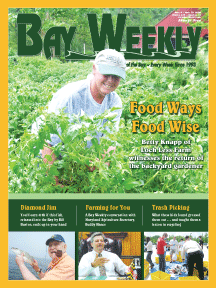
Volume XVII, Issue 23 # June 4 - June 1, 2009 |
 |
 |
The Chesapeake’s Fiercest Treat
If you are cunning and careful, it’s time to feast on the Bay’s most distinctive and delicious meat
The line started to pull out from the boat, and I tensed. Moving slowly but steadily, the unseen swimmer had mouthed the bait and decided to make it his. I felt the tension on the line as it trailed out through my fingers. This was a big one.
Ever so gradually, I added resistance until finally the devil stopped. Then, inch by inch, I began recovering the line I had lost. Swallowing suddenly, I realized that I had been salivating. Like Pavlov’s dogs, my unconscious mind was already anticipating the divine meal that would surely follow this particular adventure.
After a give-and-take struggle marked by extreme caution on my part and dogged determination by the creature on the end of my line, I caught a brief glimpse. This guy was a whale. To my son Harrison I whispered, “net, net, net.”
He slowly and quietly picked it up by its long handle, easing it into the water. He lowered the net well below where he thought our quarry might appear and waited. Finger over finger, I eased in the cotton twine the last few feet.
The broad, dark, moss-colored back of this rascal told of at least three seasons in these waters. The dirty white hue of his belly and fins told of a body chock-full of delectability. Now I was really nervous. He pulled back one more time, bullying the bait, insisting on ownership. That was his undoing.
His efforts brought him nearer the surface. In alarm, and at last realizing his exposure, he shed my bait and made for bottom. But it was too late. My son’s net was already coming up under him, and in a flash, the net lifted him clear of the water.
Trapped, the angry creature rattled his legs and spread his brilliant, blue and white claws wide, challenging anyone or anything to come near. A Chesapeake Bay blue crab does not know the meaning of fear.
This one was over seven inches point to point, stone-solid heavy. Harrison dropped him in our bushel basket to join the crabs already there. Snapping his claws and purging the water from his system so he could breathe in the air, he claimed a wide corner of the basket and waited for something to come close enough to attack.
You have to admire their valor, but there is very little catch-and-release fishing for big Bay blue crabs. They are simply too delicious to pass up, and, luckily for us who eat them, they are prolific.
Despite commercial overharvest and the continued degradation of Bay waters by agriculture and population stress, this tasty devil still manages to endure. That is indeed fortunate because these fellows provide the most distinctive and delicious meal in all the Free State.
Let’s hope that Maryland Department of Natural Resources continues in its recently successful efforts to restore a bigger and more resilient population. Maryland wouldn’t be Maryland without the blue crab.
Blue Crab Alert
Chesapeake waters have finally warmed, and the blue crab is beginning to prowl the shallows of the mid-Bay. Commercials are setting their pots in as little as six feet of water. So within a very short time, the tasty critters should be much more numerous and in range of everyone wanting to catch a few, either from shore or from a boat. Chicken necks and cotton twine will serve as well as anything. Crabbing is a great way to enjoy a day on the Chesapeake and an incredible meal as well.
Fish Are Biting
Over the last two weeks, nice rockfish to over 30 inches have been falling to chummers and chunkers, though the bite can be unpredictable. Fresh alewife, peeler crabs, soft crabs and bloodworms increasingly attract post-spawn fish eager to put on some weight. Croaker are here but still elusive, as are white perch. Small bluefish are roaming the mid-Bay but not in any numbers as yet.
Diamond Jim Alert
The Diamond Jim rockfish contest has started with 50 fish tagged and released. One of them is worth as much as $10,000 this month. July and August releases may be worth as much $20,000 and $25,000. It is all part of an effort by DNR and the State of Maryland to increase participation in Bay sport-fishing and develop public awareness of our rich natural resources.
It may also be helpful for the state to increase affordable access to the Bay. Less than three percent of the shoreline of our Chesapeake is open to the public. On our side of the mid-Bay, that figure is probably closer to one percent. There are parcels of land in state possession bordering the Bay and its tributaries that could be used for this purpose. It would be nice if the average citizen could experience more of the Chesapeake than just driving over a bridge.
© COPYRIGHT 2009 by New Bay Enterprises, Inc. All rights reserved.